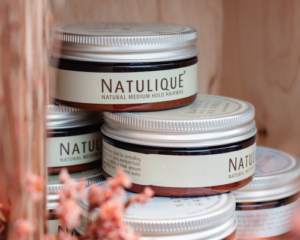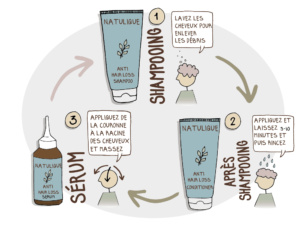Understanding the need for shampoo spacing
In our daily quest for perfect hair, we tend to overlook the importance of spacing out our shampoos. This practice, far from being trivial, plays a crucial role in the health of your hair. But why is it so important to space out your shampoos? Let's take a closer look at the reasons why spacing is such an important ally for healthier hair.
The harmful effects of excessive hair washing
Paradoxically, washing your hair too often can have a negative impact on its health. Several undesirable effects can result from this behavior:
Dry hair
Washing hair too frequently can dry it out. Water and shampoo products remove not only dirt and excess sebum, but also the essential natural oils produced by the scalp. These oils play a crucial role in moisturizing and protecting the hair fiber. Without them, hair can become dry, brittle and more prone to split ends.
Scalp alterations
The scalp itself can be damaged by excessive washing. By regularly depriving it of its natural oils, scalp skin can become irritated and itchy. Worse still, an aggressed scalp can react by producing more sebum to protect itself, creating a vicious circle where hair regrays faster than usual.
The nature of your scalp
To determine the ideal frequency of washing, it's important to consider the specific nature of your scalp, which can be either dry or oily.
Dry scalp
A dry scalp is characterized by insufficient sebum production. People with this type of scalp can often shampoo more frequently without their hair looking greasy or dirty. Washing too often will only aggravate the problem of dryness, making the hair even more vulnerable to external aggressions.
Oily scalp
On the other hand, an oily scalp produces large amounts of sebum, which can quickly make hair look oily. However, it's important not to confuse excessive sebum production with the need for constant cleansing. Spacing out shampoos can help to regulate this production by avoiding stimulating the sebaceous glands through over-frequent washing.
How to determine your ideal shampoo frequency
Shampoo spacing is not a one-size-fits-all approach. To establish the wash frequency that's best for your hair, it's crucial to carefully observe how it reacts after each shampoo, and to take into account the specific characteristics of your hair and lifestyle.
Observe how your hair reacts after shampooing
The signals your hair emits after a wash can be very revealing, and will help you adjust the frequency of your shampoos to its specific needs.
Hair that regrays quickly
If your hair tends to re-grease quickly after shampooing, this may be an indicator of over-production of sebum or excessive stimulation of the sebaceous glands. Although it's tempting to wash frequently to counteract this excess oil, spacing out shampoos can sometimes offer a more lasting solution, allowing the scalp to regain its natural balance. Try to gradually reduce the frequency of washing while incorporating alternative solutions, such as dry shampoo, to combat the greasy look.
Hair that stays dry for days
On the other hand, if your hair remains dry for several days after washing, this may suggest that you can easily space out your shampoos. This hair often benefits from increased hydration when it's not washed daily, so a more spaced-out washing frequency could help solve dryness problems. In this case, a more spaced washing rhythm will only improve hydration and the overall health of the hair.
Take your hair type and lifestyle into account
Beyond simple observation, it's essential to adapt your washing routine to the particularities of your hair and your daily routine. These factors have a considerable influence on the frequency of shampooing that suits you best.
Fine hair vs. thick hair
Fine hair tends to become greasy more quickly than thick hair, as it has less mass to absorb natural oils. If you have fine hair, consider washing more frequently, always using gentle products. Thick hair, on the other hand, may require fewer washes, benefiting from a better distribution of natural oils over its volume.
Physical activity and perspiration
Your lifestyle, and particularly your level of physical activity, also plays a major role in determining the ideal frequency of your shampoos. Intense or frequent physical activity can lead to increased perspiration, potentially necessitating more regular washing. However, in this case, it's crucial to focus on eliminating perspiration while preserving scalp and hair health, perhaps by focusing shampoo on the scalp rather than the whole head of hair. Adjust your washing habits in line with your exercise routines to find a balance that promotes both hygiene and hair health.
See also: How to add volume with a hair wax?
Techniques to space out your shampoos
Keeping shampoos at bay without compromising the appearance of your hair may seem complicated, but with a few simple tricks, the process becomes much easier and more profitable for your hair's health. Here are a few tried-and-tested techniques for effectively spacing out your washes while keeping your hair healthy and fresh.
Use dry shampoo
Dry shampoo is a popular solution for refreshing hair between washes. This absorbent product eliminates excess sebum, gives hair volume and texture, and helps extend the time between your traditional shampoos.
How to use dry shampoo effectively
- Shake well: Before application, shake the bottle well to ensure even mixing of the absorbent powders.
- Apply directly to the roots: Spray about 20 cm from your hair, targeting the roots where oil accumulates most.
- Massage the scalp: Use your fingers to gently massage the product into the roots; this will help distribute the powder evenly and absorb the oil.
- Brush to remove excess: Brush your hair to remove any powder residue and give your hair a natural, clean look.
Adopting the right hair care routine
Having a hair routine that supports your efforts to space out shampoos is essential. This includes not only the products you use, but also the way you look after your hair on a daily basis.
Use the right products
- Serums and light oils: Incorporate moisturizing products that nourish without weighing hair down, such as serums or light oils applied to the ends only.
- Leave-in conditioner : To maintain optimal hydration between washes, consider using a leave-in conditioner. It helps detangle and add softness without building up product.
Styling techniques
- Opt for protective hairstyles: Adopt protective hairstyles such as braids, buns or ponytails. They protect your hair from external aggressions and reduce contact with your hands, minimizing the transfer of dirt and oil.
- Limit the use of heated tools: Reduce the use of straightening irons and hair dryers, which can dry out and damage your hair, making more frequent washing necessary.
Integrating a balanced diet
In addition to external techniques, a healthy diet also plays a crucial role in the health of your hair, helping to regulate sebum production and keep your hair healthy for longer.
Preferred foods
- Omega-3 fatty acids : Eat oily fish, nuts and seeds to improve scalp health and reduce excess sebum.
- Vitamin E : Found in avocados, almonds and spinach, it contributes to hair growth and hydration.
- Antioxidants : Incorporate berries, green tea and dark chocolate to protect your hair from environmental damage.
Personalized shampoo spacing advice
Listen to your scalp
Every scalp is unique, and it's crucial to be attentive to its specific needs. Listening to what your scalp is telling you can help determine the perfect wash routine for you.
Appreciating telltale symptoms
Itching, the appearance of dandruff, or a feeling of stretched skin are indicators of an unbalanced scalp. If these symptoms appear, you may need to adjust the frequency of your washings to restore optimal comfort.
Adopt a flexible approach
Rather than sticking to a rigid schedule, be flexible with your hair routine. Understand that external factors such as climate or stress can influence the health of your hair, so adjust your shampoo frequency accordingly.
Include complementary care
Nourishing hair masks
Incorporate the weekly use of hair masks to deeply moisturize and revitalize your hair. These in-depth treatments provide a protective barrier, strengthening your hair between washes.
Scalp massages
Regular, gentle scalp massages with fingers or a massage brush stimulate blood circulation and promote healthy hair growth. These massages also encourage the production of natural oils, helping to balance the scalp.
Rethink your styling habits
Minimal use of styling products
Reduce excessive use of gels, lacquers and other styling products that can weigh hair down and require frequent washing. Choose natural products or those designed without heavy residues for better breathability of your hair and scalp.
Dry your hair naturally
Let your hair air-dry as much as possible, limiting the use of blow-dryers, which can damage the hair fiber and lead to greater sebum production.
FAQ on shampoo spacing
Why does my hair re-grease more quickly when I start spacing out my shampoos?
As you start to space out your washings, your scalp may react by producing more sebum, but this tends to regulate itself over time.
How important is water in my washing routine?
Using lukewarm rather than hot water is essential, as hot water can strip your hair of its natural oils, causing dryness and irritation.
Does the type of brush I use have an impact?
Yes, using a natural-fiber brush helps distribute the oils more evenly over the length of the hair, promoting health and shine.
How long does it take to adapt my scalp to a new washing routine?
It may take a few weeks for your scalp to get used to a new shampoo frequency and adjust its sebum production accordingly.
Can the size of my pillowcase affect my hair?
Yes, opting for a silk or satin pillowcase reduces friction, minimizing breakage and helping to maintain your hair's natural moisture.





